The road to success – from beginner to pro player
Coaching on the youth level requires you to consider a variety of factors
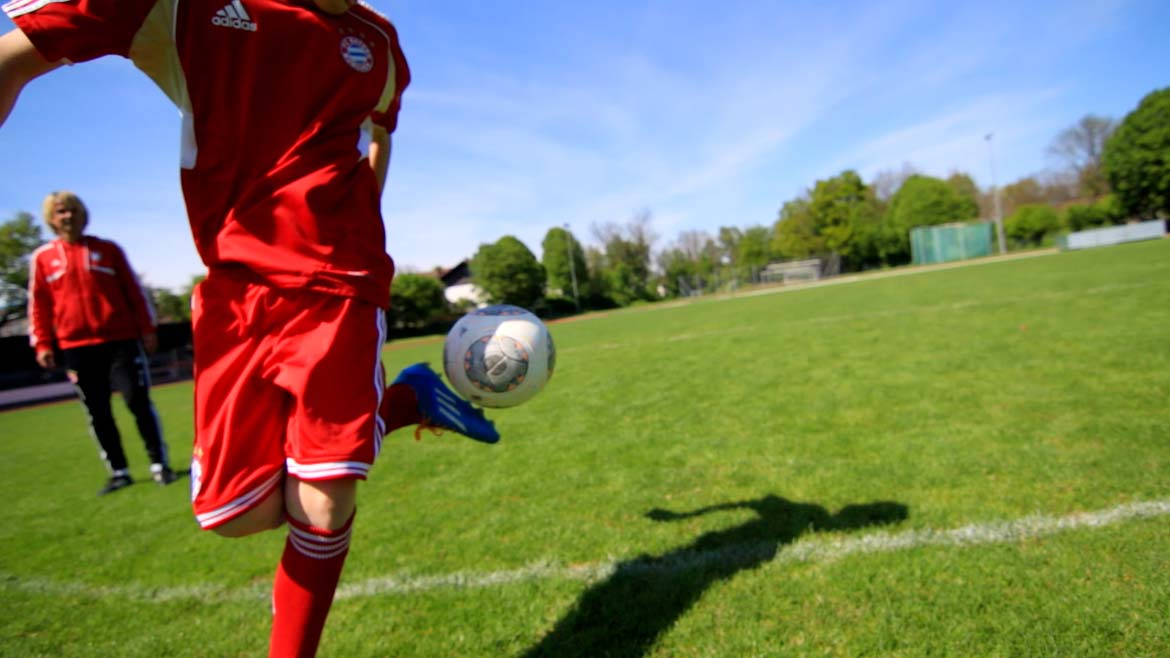 Making moves: youth players know how to dance with the ball
Making moves: youth players know how to dance with the ballHow can I optimize my training program? When should i start strength and endurance practice?
What qualities make you a great youth soccer coach?
Questions upon questions – but don’t worry, your new assistant coach has the answers!
Soccer appeals to children all around the globe. Kids want to kick it like Beckham or dribble the ball like Messi. But soccer is more than just a game. When you look at soccer from a social and cultural point of view, you can’t underestimate the importance of this sport because it allows young children to participate in a group setting that requires teamwork, proper conduct and the capability to obey rules.
At the same time, as a youth coach you have to be able to adjust the requirements of your training program to each particular age group that you’re responsible for because a variety of factors such as puberty, growth phases and extracurricular activity gain more and more importance and the quality of training is becoming increasingly demanding – for coaches and players.
Soccercoachclinics now wants to give you a few guidelines that define the most important aspects of substantial and age-appropriate player development – from kids cutting their teeth to promising prospects contemplating whether to go pro.
4-6 year olds (U5, U6, kids clubs, bambinis)
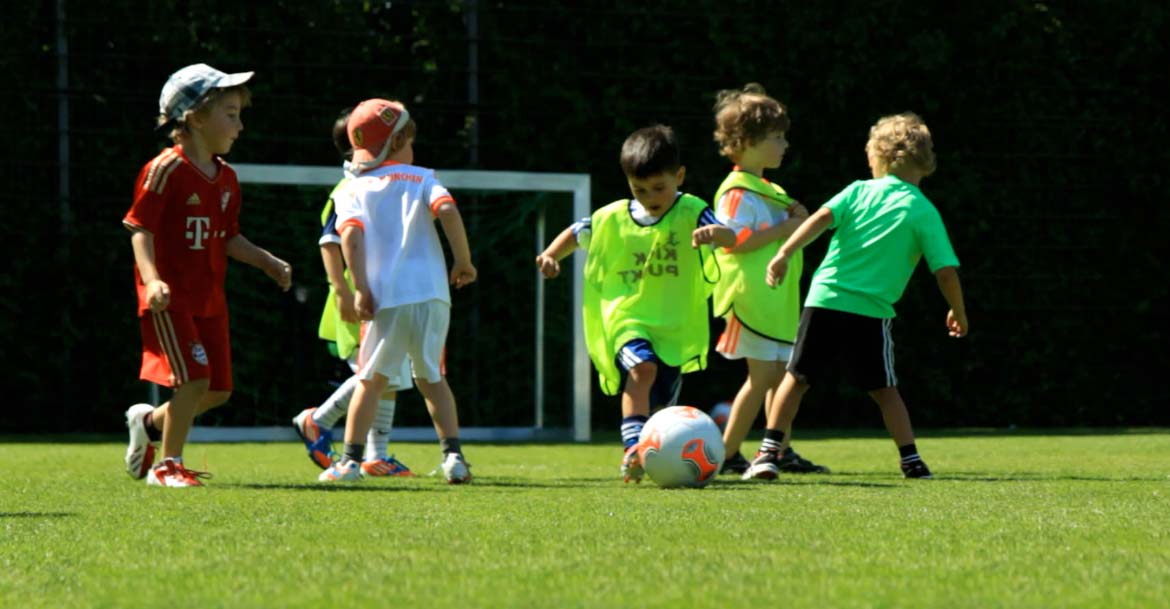 The youngest soccer players only know way – after the ball
The youngest soccer players only know way – after the ballHaving fun is the top priority when you’re coaching the youngest soccer players out there. That’s why you should lay the focus in your training program accordingly. Training games and drills that contain many fun and playful elements are key in teaching soccer beginners the fundamentals of the game. This way you can automatically deal with other important aspects like the improvement of strength and mobility, the training of ball control skills, or the ability to focus and to adjust.
Furthermore you should always remember to keep the young boys and girls engaged as much as possible. Incorporate the use of the ball as often as you can and divide the kids into smaller groups in order to ensure that they stay motivated throughout practice. Standing in line and waiting for minutes just to kick the ball once or twice is certainly not the best way for a young soccer player to learn the soccer basics.
Your role as a coach is crucial for the development of the players you coach. At this age the kids much rather need a positive big brother type of coach, rather an a stoic authority figure standing on the sideline.
Ideally you should be able to hold two 60-minute training sessions a week, but always be aware of the fact that completive matches and a pressure to perform should be avoided when coaching this age group. If possible, you should rather try to arrange occasional exhibition matches (friendlies) with other teams. Once a friendly is scheduled, you should tell your players that the result is not of importance, you simply want them to have fun playing the game. Each player on your team should get the same amount of playing time in order to encourage team spirit and to avoid any form of exclusion of one of your players.
Here’s a quick recap:
- try to encourage the players to have fun playing soccer
- training games and fun and playful drills are top priority
- keep the kids engaged throughout practice
- don’t be too commanding
- two 60-minute training sessions a week
- no competitive matches, only friendlies
- equal playing time for everyone
U2 to U9 players
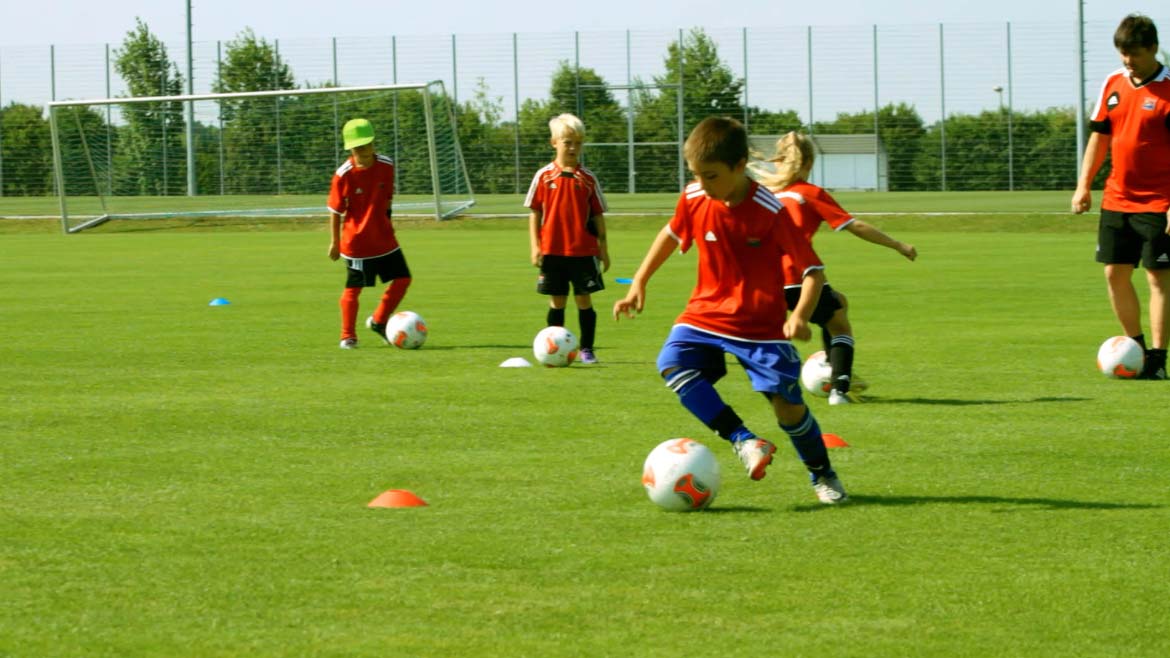 Prolific dribbling moves take practice
Prolific dribbling moves take practiceWhen you’re coaching boys and girls in this age group you can start to train their coordination skills for the first time, but when you do, you should always make sure to incorporate the ball at all times, thus always combining the drill with a pass or a shot on goal.
Each practice should include game-related drills that can be enhanced with special tasks, i.e. goals are worth two points when a certain move or trick was performed first. Every kid on the team should get a chance to go through each position during the drill.
Training sessions for players of this age group should be held twice a week and can take up to 90 minutes.
Your role as a coach is just as crucial as before, you should try to be a role model and someone who the kids can trust. Competitive matches can be a double-edged sword here because on the hand the competitive spirit and the ambition of the players shouldn’t be neglected completely, on the other hand, too much competition can lead to misguided goals and priorities and a lack of proper development of the young soccer players.
One of our cooperation partners, the soccer academy Unterhachhing, takes a brand new approach to this quandary – there kids from the ages of four to nine can train in a well-structured and professional fashion, but without having the pressure of having to produce results in competitive matches. The coaches lay the focus on coordinative education, fun, adaptation to the ball and social behavior.
Here’s a quick recap:
- initial coordination training sessions
- primarily game-related drills
- no long waiting periods (many balls and stations)
- rotate positions during drills
- try to be a role model and someone who your players can trust
- two 90-minute training sessions a week
- make a decision for or against competitive matches
U10 to U12 players (The golden age of learning!)
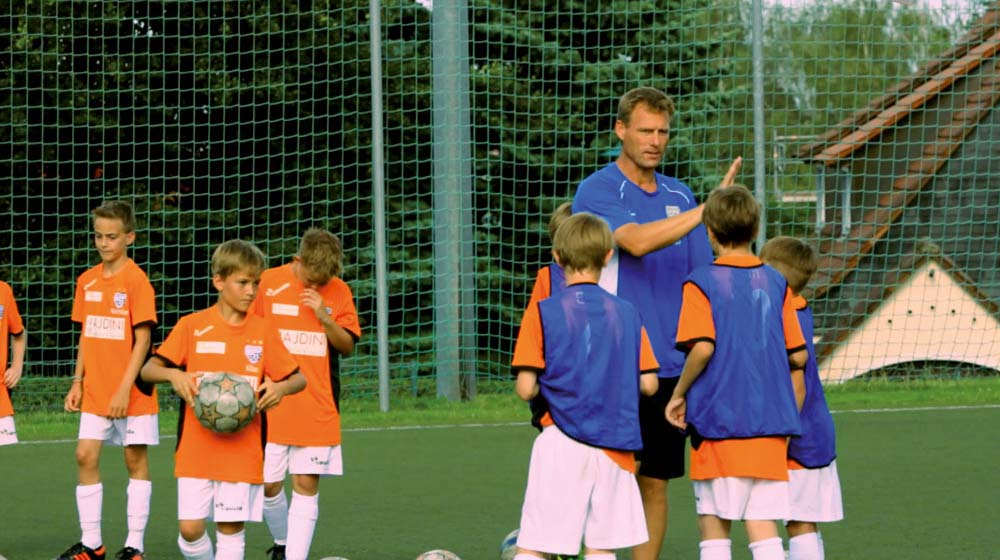 Gimme five: coaches should constantly keep motivating their players
Gimme five: coaches should constantly keep motivating their playersThe period from age nine to twelve is called “the golden age of learning”. During this time children are very receptive to learning new skills and knowledge. At the same they take large steps in their physical development, therefore coordination drills and exercises are vital at this stage. You should definitely try to take advantage here and always incorporate the ball in whatever you do. The improvement of the players’ technical skills should also play a major role. You should lay the foundation for basically anything that a great soccer player should have in his or her repertoire – tricks, feints, one-on-one moves, the ability to use both feet, you name it…
Technical skills and tactical awareness go hand in hand! At this stage it does make sense to start teaching tactical fundamentals to your players – when you’re coaching a U12 team you could even start to work on more complex systems and plays. However, this is only possible if you have laid the foundation on a technical skill level. Your players simply won’t be able to implement systems or plays if they’re not able to pass or to trap and control the ball.
When you incorporate tactical elements you have to make sure that the players have sufficient cognitive skills and athleticism. The players have to be able to make quick decisions in order to apply pressing and to shift from defense to attack mode. You can either incorporate strength exercises into your training routine or you could give your players a small to do-list with tasks and exercises that they should complete individually.
Your coaching role takes up even more significance during this period because you can now no longer just be a buddy or a big brother, you also have to introduce rules and boundaries that your players have to adhere to. This is necessary not only to be able to conduct a structured training session but also to encourage team spirit and social behavior of the players. You have to able to convey to your players that along with technical skills social aspects such as teamwork and togetherness are crucial in soccer. The team always comes first!
As I mentioned before, this is first time that you can actually tell your players to work on certain aspects individually, as long as they have motivation for it, of course.
In order to be able to implement technical and tactical aspects into actual matches, you should try to find opposing teams that are on a somewhat equal level as your squad. When you try to determine the actual level of talent and progress of your team, it might be recommendable to play opponents with a higher level of talent. Your players shouldn’t have one fixed position, try to play them on different positions and explain them the ins and outs of each position.
Here’s a quick recap:
- lay the focus on technical aspects and coordination
- “the golden age of learning”
- always incorporate the use of the ball
- initial tactical and technical training sessions
- drills to improve athleticism and cognitive skills
- social behavior and team spirit
- give your players rules and boundaries
- two 90-minute training sessions a week
- play superior and inferior teams
- rotate players to different positions
U13 to U18 players
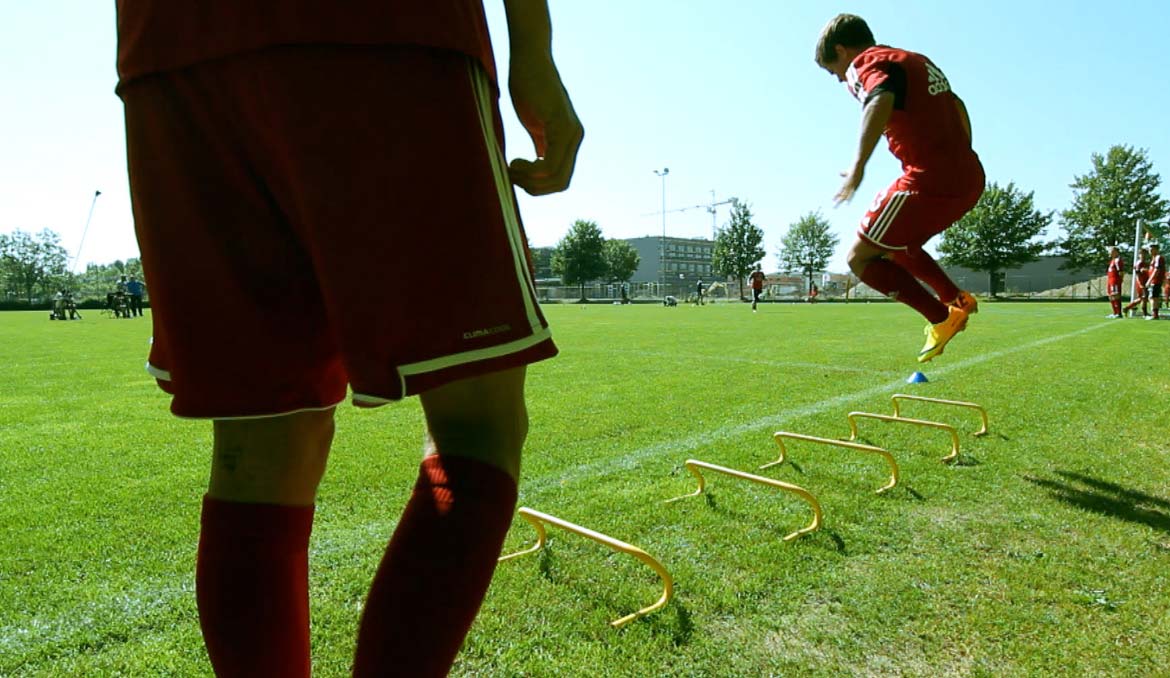 Jump! Mini hurdles are a great tool to train your player’s jumping ability
Jump! Mini hurdles are a great tool to train your player’s jumping abilityWhen you’re coaching U13 and U14 teams your players ideally have already acquired the necessary fundamental skills when they went through the previous age groups, so that you now can start to lay the focus on improving strength, athleticism, speed and endurance. This doesn’t mean that you can now neglect working on technical skills and coordination aspects, instead you should combine these aspects in the drills you let your players perform. The older your players get the more important it is that perform at a high pace, yet all while remaining precise throughout.
Tactical training is essential when you’re coaching this age group. In accordance with your club’s philosophy and the player material you have, you should now practice plays, set pieces and tactical subtleties. This pertains both team tactical issues and individual tactical measures. If you have video scouting tools at your disposal you should definitely take advantage of them.
U13 and U14 players now should have fixed positions and you should train your players accordingly. Naturally, goalkeepers need to be trained differently than their outfield teammates. After you’ve determined who is suited to play what position the goal is to ‘breed’ technical and tactical specialists for their respective position on the pitch.
Since the kids go through a difficult phase during this time your job as a coach requires you to be tactful and understanding. Some of your players in this age might be hard to handle that’s why your people management skills are required as well.
When you’re coaching U17 and U18 players you have to remember that other activities and obligations come to the fore, regardless whether they’re related to school, job, or the player’s private life. Therefore soccer shouldn’t be a burden for them, instead it should be fun and it should offset any kind of troubles the boy or girl might have. Of course it’s not easy to find a good balance here but this is part of what makes you a good coach.
You should now significantly raise practice time and frequency, which equates to four training sessions a week in an ideal scenario. Since both the quality and the amount of training content gets increased, it is absolutely a possibility to carry out training sessions that last up to 120 minutes. When you’re able to divide the training sessions in a reasonable fashion you should be able to cover the most important aspects of youth soccer training (technical skills, coordination, tactics, speed and endurance), and to maximize the practice time you have.
Here’s a quick recap:
- lay the focus on strength, speed, endurance and athleticism
- strengthen your players’ technical skills and coordination
- work on your player’s tactical awareness
- fixed positions and practice specifically to the player’s position
- be a commanding but understanding and patient coach
- consider private or job/school related issues your players might have
- four raining sessions (90 to 120 minutes) a week
U13 to U18 players
Most kids start off playing soccer in school or at a local club and to them it’s just a hobby and a way to spend their pastime. While many of the young boys and girls dream of playing professionally one day, there’s only a few that will actually get a chance to realize their dream. Even when you do everything you can it’s more than likely that you will come back down to earth with a bang rather sooner than later. There are so many factors that have to align perfectly in order for you to turn your hobby into a career, regardless whether this is talent, hard work, decision-making or simply pure luck.
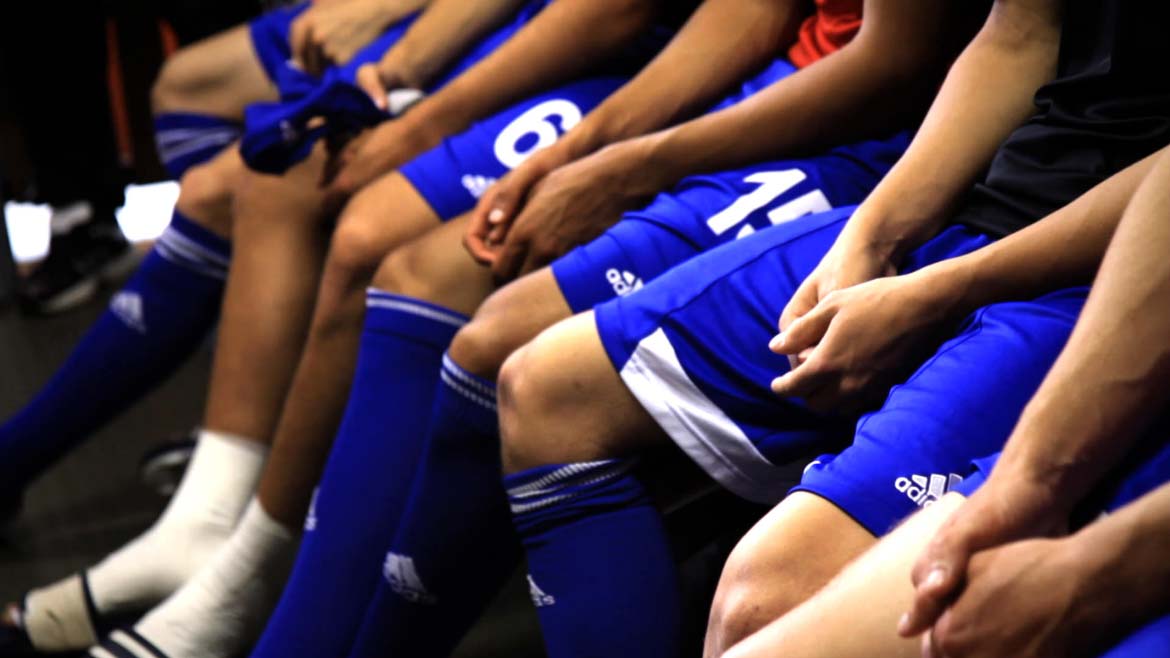 Calm before the storm: pre-game is all about focus
Calm before the storm: pre-game is all about focus While it’s certainly a great opportunity for a young talent to go to college on a soccer scholarship, he or she has to realize that attending a university for four years can also impede the process of turning pro. When the player graduates he/she will most likely be around the age of 22, and at that stage many European pro clubs might have already lost interest in the player since the level of competition he/she has played on for the last four years is simply too inferior in order for the player to make an impact right away. However, most American soccer players who play in the MLS have gone the conventional route of playing collegiately before turning pro, therefore this strategy certainly should not be ruled out categorically.
On the other hand a move to a club in Europe has its pros and cons as well. While the level of competition is much higher and the exposure to a wider audience is an advantage, the player definitely has to be prepared for a “culture shock” once he leaves the US for the first time. As a young American it’s not unlikely to have a hard time adjusting to living in a foreign country, and if that’s the case, the move will certainly be rather detrimental than positive for his development.

